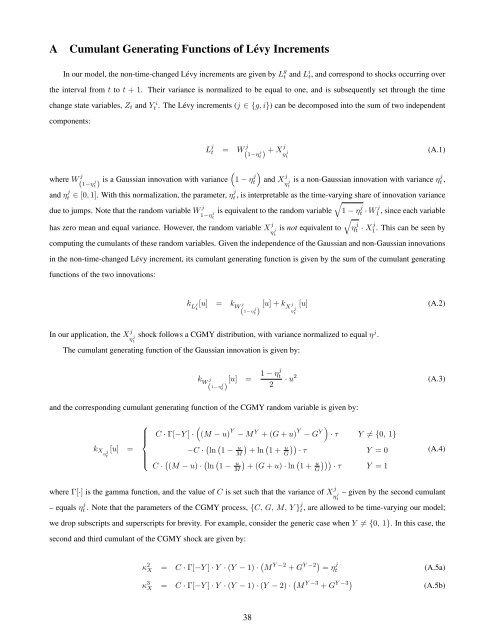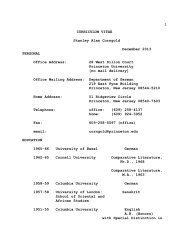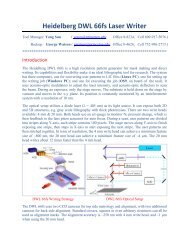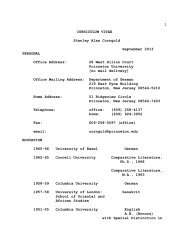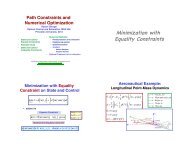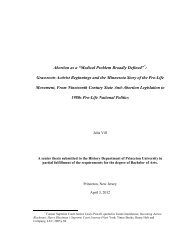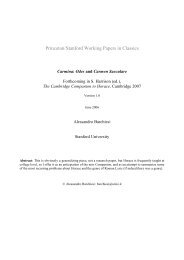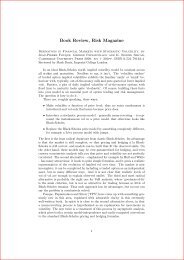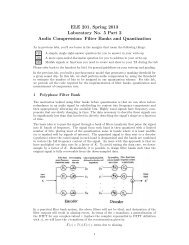Option-Implied Currency Risk Premia - Princeton University
Option-Implied Currency Risk Premia - Princeton University
Option-Implied Currency Risk Premia - Princeton University
Create successful ePaper yourself
Turn your PDF publications into a flip-book with our unique Google optimized e-Paper software.
A<br />
Cumulant Generating Functions of Lévy Increments<br />
In our model, the non-time-changed Lévy increments are given by L g t and L i t, and correspond to shocks occurring over<br />
the interval from t to t + 1. Their variance is normalized to be equal to one, and is subsequently set through the time<br />
change state variables, Z t and Y i<br />
t . The Lévy increments (j ∈ {g, i}) can be decomposed into the sum of two independent<br />
components:<br />
L j t = W j (1−ηt) + j Xj η j t<br />
)<br />
where W<br />
(1 j<br />
(1−ηt) is a Gaussian innovation with variance − η j j t and X j η j t<br />
(A.1)<br />
is a non-Gaussian innovation with variance η j t ,<br />
and η j t ∈ [0, 1]. With this normalization, the parameter, η j t , is interpretable as the time-varying share of innovation variance<br />
√<br />
due to jumps. Note that the random variable W j is equivalent to the random variable 1 − η j 1−η j t · W j 1 , since each variable<br />
t<br />
√<br />
has zero mean and equal variance. However, the random variable X j is not equivalent to η j η j t · X j 1 . This can be seen by<br />
t<br />
computing the cumulants of these random variables. Given the independence of the Gaussian and non-Gaussian innovations<br />
in the non-time-changed Lévy increment, its cumulant generating function is given by the sum of the cumulant generating<br />
functions of the two innovations:<br />
k L<br />
j [u] = k<br />
t<br />
W<br />
j<br />
( 1−η<br />
t) [u] + k j X j [u]<br />
η j t<br />
(A.2)<br />
In our application, the X j η j t<br />
shock follows a CGMY distribution, with variance normalized to equal η j .<br />
The cumulant generating function of the Gaussian innovation is given by:<br />
k W<br />
j<br />
( 1−η j t) [u] = 1 − ηj t<br />
2<br />
· u 2 (A.3)<br />
and the corresponding cumulant generating function of the CGMY random variable is given by:<br />
k Xη j<br />
[u] =<br />
t<br />
⎧<br />
⎪⎨<br />
⎪⎩<br />
)<br />
C · Γ[−Y ] ·<br />
((M − u) Y − M Y + (G + u) Y − G Y · τ Y ≠ {0, 1}<br />
−C · (ln ( ) (<br />
1 − u M + ln 1 +<br />
u<br />
G))<br />
· τ Y = 0<br />
(A.4)<br />
C · ((M<br />
− u) · (ln ( ) ( )))<br />
1 − u M + (G + u) · ln 1 +<br />
u<br />
G · τ Y = 1<br />
where Γ[·] is the gamma function, and the value of C is set such that the variance of X j η j t<br />
– given by the second cumulant<br />
– equals η j t . Note that the parameters of the CGMY process, {C, G, M, Y } j t, are allowed to be time-varying our model;<br />
we drop subscripts and superscripts for brevity. For example, consider the generic case when Y ≠ {0, 1}. In this case, the<br />
second and third cumulant of the CGMY shock are given by:<br />
κ 2 X = C · Γ[−Y ] · Y · (Y − 1) · (M Y −2 + G Y −2) = η j t (A.5a)<br />
κ 3 X = C · Γ[−Y ] · Y · (Y − 1) · (Y − 2) · (M Y −3 + G Y −3) (A.5b)<br />
38


